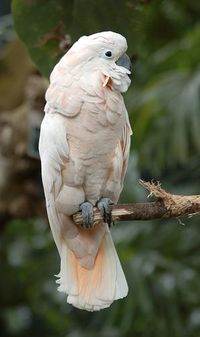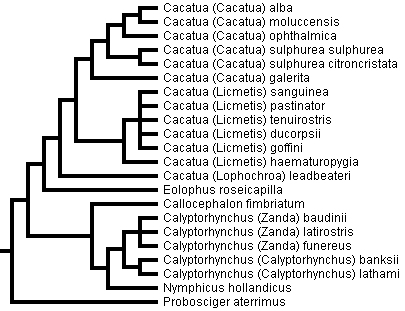| Cockatoos | ||||||||||
|---|---|---|---|---|---|---|---|---|---|---|

Moluccan Cockatoo (Cacatua (Cacatua)
moluccensis)
|
||||||||||
| Scientific classification | ||||||||||
|
||||||||||
|
Microglossinae Calyptorhynchinae Cacatuinae |
A cockatoo is any of the 21 bird species belonging to the family Cacatuidae. Along with the Psittacidae family (the true parrots), they make up the order Psittaciformes. The name cockatoo originated from the Malay name for these birds, kakaktua, which translates literally as older sister (from kakak, "sister," and tua, "old").
Cockatoos share many features with other parrots including the characteristic curved beak shape and a zygodactyl foot, with two forward toes and two backwards toes. They differ, however in a number of characteristics, including the often spectacular movable headcrest, the presence of a gall bladder and some other anatomical details, and their lack of the Dyck texture feather composition which causes the bright blues and greens seen in true parrots. Cockatoo species are also, on average, larger than the true parrots (however, the cockatiel is a small cockatoo and the very large parrots include the Hyacinth Macaw by length and the Kakapo by weight.)
Cockatoos have a much more restricted range than the true parrots, occurring naturally only in Australia and nearby islands. Eleven of the 21 species exist in the wild only in Australia, while seven species occur in Indonesia, New Guinea, and other south Pacific islands. Three species occur in both New Guinea and Australia.
Contents |
Cockatoos as endangered or vulnerable species
All of the species of cockatoo are protected by the CITES international agreement, which makes the trade of wild-caught specimens of endangered or vulnerable species illegal.
The following cockatoo species are classified as endangered species (on CITES appendix 1 list).
- Goffin's cockatoo, Cacatua goffini
Red-vented Cockatoo, Cacatua haematuropygia
Moluccan Cockatoo, Cacatua moluccensis
Yellow-crested Cockatoo, Cacatua sulphurea
Palm Cockatoo, Probosciger aterrimus
All of the other cockatoo species are classified at vulnerable (on CITES appendex 2 list).
Systematics

Brown & Toft (1999) reviewed the existing evidence and additional mitochondrial 12S rRNA sequence data to arrive at a well-supported phylogeny of the cockatoos. They could distinguish 3 subfamilies:
- The all-black Palm Cockatoo represents an early divergence; it was previousöly sometimes grouped with the other black species but this is incorrect.
- The dark cockatoos; sexually dichromatic species which have ample melanin in their plumage and some red, yellow or orange on wing, tail and face, barred feathers on wing, tail and/or body as well as contrasting ear area spotting in females, while males have the corresponding feathers unbarred and may lack the ear spotting. This group includes the remaining black cockatoos, the Gang-gang Cockatoo and, interestingly, the cockatiel which had previously been placed in a subfamily of its own (Nymphicinae) or even as a broad-tailed parrot.
- The remaining species, which are all hypomelanistic and not sexually dimorphic.
The genera Calyptorhynchus and Cacatua can be further resolved into two subgenera each, and in the latter case as a distinct third lineage the white-and-pink Major Mitchell's Cockatoo, which is intermediate in coloration between the grey-and-pink Galah and the white Cacatua. It is best recognized as a monotypic genus Lophocroa. Indeed, pending further research, all subgenera could conceivably be raised to species rank.
FAMILY CACATUIDAE
- Subfamily
Microglossinae
- Genus
Probosciger
- Palm Cockatoo, Probosciger aterrimus
- Genus
Probosciger
- Subfamily
Calyptorhynchinae - dark cockatoos
- Genus
Callocephalon
- Gang-gang Cockatoo, Callocephalon fimbriatum
- Genus
Nymphicus
- Cockatiel, Nymphicus hollandicus
- Genus
Calyptorhynchus
- Subgenus Calyptorhynchus -
black-and-red cockatoos
- Red-tailed Black Cockatoo,
Calyptorhynchus (Calyptorhynchus) banksii
Glossy Black Cockatoo, Calyptorhynchus (Calyptorhynchus) lathami
- Red-tailed Black Cockatoo,
Calyptorhynchus (Calyptorhynchus) banksii
- Subgenus
Zanda - black-and-yellow/white cockatoos
- Yellow-tailed Black Cockatoo,
Calyptorhynchus (Zanda) funereus
Short-billed Black Cockatoo, Calyptorhynchus (Zanda) latirostris
Long-billed Black Cockatoo, Calyptorhynchus (Zanda) baudinii
- Yellow-tailed Black Cockatoo,
Calyptorhynchus (Zanda) funereus
- Subgenus Calyptorhynchus -
black-and-red cockatoos
- Genus
Callocephalon
- Subfamily
Cacatuinae - white cockatoos
- Genus
Eolophus
- Galah, Eolophus roseicapilla
- Genus
Lophocroa
- Major Mitchell's Cockatoo, Lophocroa leadbeateri
- Genus
Cacatua
- Subgenus
Licmetis - corellas
- Long-billed Corella, Cacatua (Licmetis)
tenuirostris
Western Corella, Cacatua (Licmetis) pastinator
Little Corella, Cacatua (Licmetis) sanguinea
Red-vented Cockatoo, Cacatua (Licmetis) haematuropygia
Goffin's Cockatoo, Cacatua (Licmetis) goffini
Ducorps' Cockatoo, Cacatua (Licmetis) ducorpsii
- Long-billed Corella, Cacatua (Licmetis)
tenuirostris
- Subgenus Cacatua - true white
cockatoos
- Sulphur-crested Cockatoo, Cacatua (Cacatua) galerita
-
Yellow-crested Cockatoo, Cacatua
(Cacatua) sulphurea
- Citron-crested Cockatoo, Cacatua (Cacatua) sulphurea citrinocristata
- Blue-eyed Cockatoo, Cacatua (Cacatua)
ophthalmica
Moluccan Cockatoo or Salmon-crested Cockatoo, Cacatua (Cacatua) moluccensis - Umbrella Cockatoo, Cacatua (Cacatua) alba
- Subgenus
Licmetis - corellas
- Genus
Eolophus
References
- Brown, D.M. & Toft, C.A. (1999): Molecular systematics and biogeography of the cockatoos (Psittaciformes: Cacatuidae). Auk 116(1): 141-157.
External links
- Lexicon of Parrots
- ParrotScience - cockatoo heavy information site
- The Palm Cockatoo Research project - a collaborative wiki style site about Palm Cockatoos
- Notes on Brown & Toft's phylogenetic study
- Brown & Toft's article
- All About Cockatoos - MyToos.com, comprehensive site with discussion forum and warning about their care requirements.
- Wings n' Whiskers Major Mitchell Cockatoo Page
- Royal Society for the Protection of Birds website - threats to wild bird populations




 216.73.216.91
216.73.216.91 User Stats:
User Stats:
 Today: 0
Today: 0 Yesterday: 0
Yesterday: 0 This Month: 0
This Month: 0 This Year: 0
This Year: 0 Total Users: 117
Total Users: 117 New Members:
New Members:
 216.73.xxx.xx
216.73.xxx.xx
 Server Time:
Server Time: